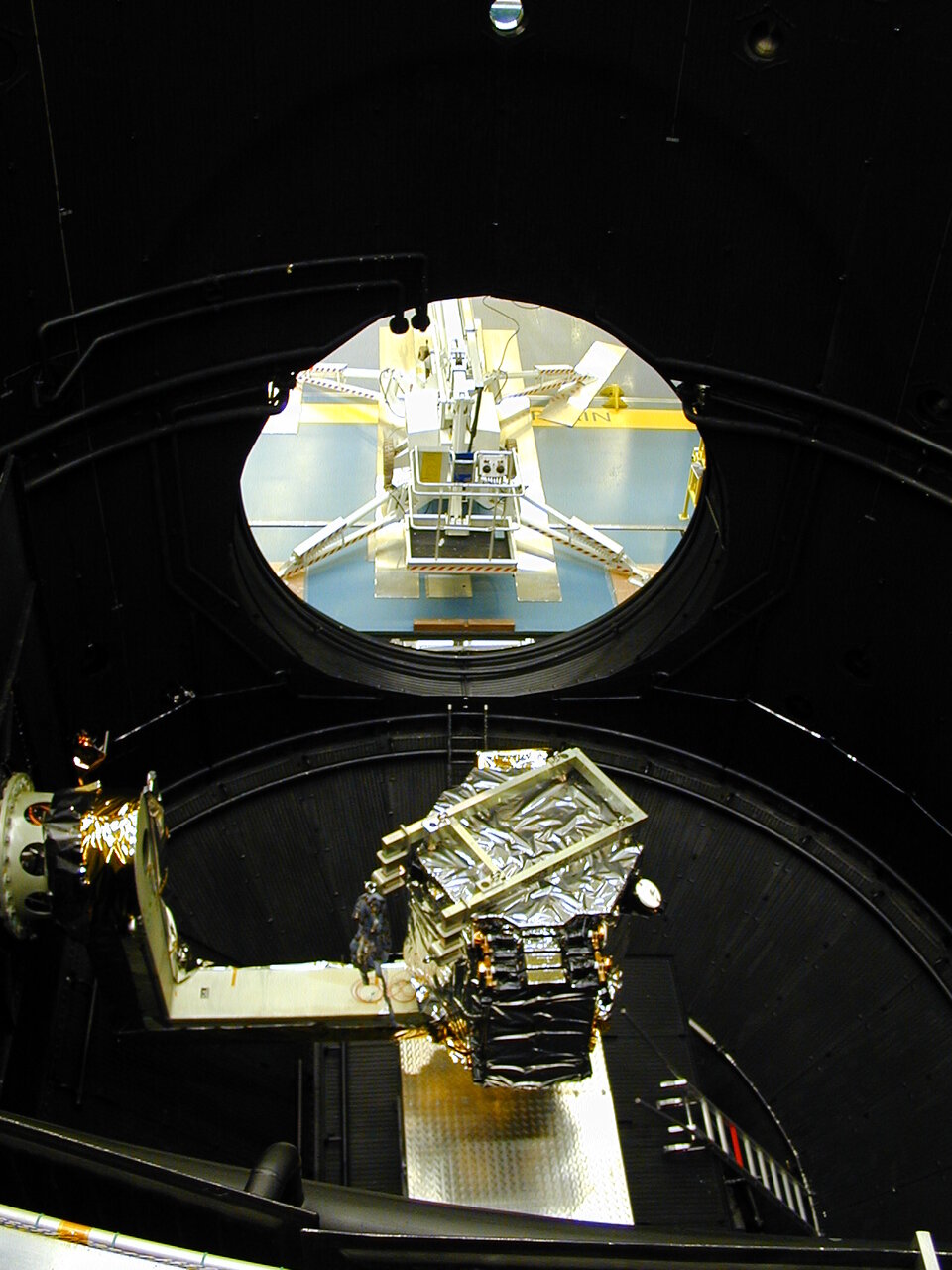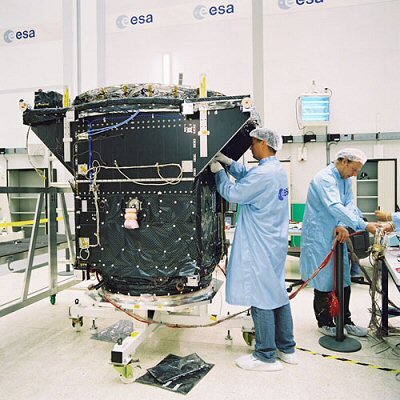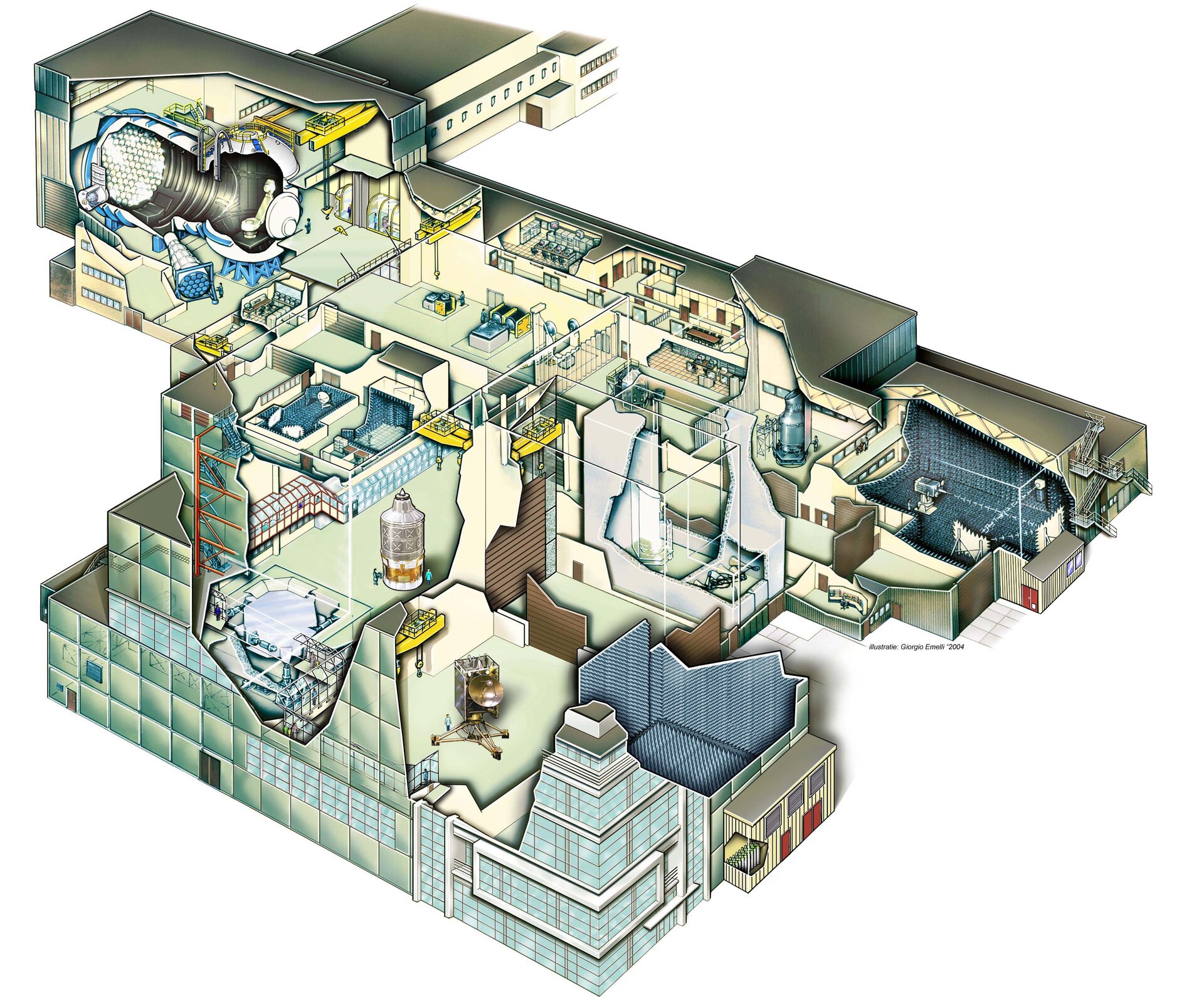High level of activity at the ESTEC Test Centre
The European Space Agency’s Test Centre has been very busy over the past few weeks, with two complete spacecraft and two major spacecraft modules in the facility undergoing a variety of tests.
ESA maintains a large centre for the testing of space vehicles and their subsystems at its European Space Research and Technology Centre (ESTEC), located at Noordwijk in The Netherlands. The ESTEC Test Centre has the capability of simulating the conditions that large spacecraft will experience during launch and once they are in space.
During the spring and early summer of 2005, the ESTEC Test centre has been particularly busy, with four major projects preparing or running test campaigns simultaneously.
Herschel

Herschel, a project within ESA’s Science Programme, is a space telescope. It is made up of a payload module, comprising the telescope mirrors and instruments, and a service module that houses the systems required to operate the spacecraft, such as propulsion and communications.
The Herschel service module flight hardware was tested under conditions simulating those it will experience in space using the Large Space Simulator (LSS). By subjecting the hardware to high vacuum, low temperatures and simulated solar illumination, the performance under actual flight conditions can be determined.
The mass properties of the service module, such as the position of its centre-of-mass and its moment of inertia, were also verified.
Subsequently, the Herschel service module went into storage in the Test Centre to wait for mating with the payload module followed by spacecraft level testing later this year.
SMOS

The Soil Moisture and Ocean Salinity (SMOS) mission has been designed to observe soil moisture over the Earth's landmasses and salinity over the oceans. Soil moisture data are urgently required for hydrological studies and data on ocean salinity are vital for improving our understanding of ocean circulation patterns.
A mechanically and thermally representative version of the SMOS Payload Module (PLM), referred to as a Structural/Thermal Model (STM) was in the Test Centre undergoing testing to confirm the hardware performance corresponds with that predicted during the design process.
The SMOS STM has undergone acoustic testing in the Large European Acoustic Facility (LEAF). During this test, the spacecraft was exposed to the extremely high sound pressure levels that the flight hardware will experience under the launcher fairing during the early part of its journey into orbit.
During launch, SMOS will also be subjected to severe vibration. The STM has been subjected to vibration testing on the Test Centre’s Multi-shaker System. The Multi-shaker System comprises two 160kN electrodynamic shakers, coupled together to enable the testing of large spacecraft and subsystems.
The SMOS STM also spent about three weeks in the LSS. In addition to analysing its performance under simulated space conditions, the effects of the thermal cycling that the spacecraft will experience as it moves repeatedly in and out of eclipse were investigated.
ADM-Aeolus

The ADM-Aeolus satellite, part of ESA’s Living Planet programme, will perform global observations of wind profiles from space using Doppler LIDAR (laser radar) to improve the quality of weather forecasts, and to advance our understanding of atmospheric dynamics and climate processes.
The mechanically representative version of the ADM-Aeolus spacecraft, referred to as the Structural Model (StM), was in the Test Centre undergoing testing to confirm the hardware performance corresponds with mechanical design predictions.
The ADM-Aeolus StM has undergone acoustic testing in LEAF to determine its performance when exposed to the extremely high sound pressure levels that the flight version will experience during launch.
During launch, ADM-Aeolus will also be subjected to vibration and mechanical shocks. The StM has been subjected to vibration testing on the Test Centre’s Multi-shaker System and to tests simulating the shocks it will experience at launcher separation.
ATV

Automated Transfer Vehicles (ATVs), part of ESA’s contribution to the International Space Station, will carry equipment and supplies up to the station about once per year.
The flight hardware for the first ATV mission, named Jules Verne, is currently undergoing integration in the ESTEC Test Centre prior to moving into LEAF for acoustic testing.
Jules Verne will also undergo testing in the Large Space Simulator.
Galileo GSTB-V2/A

GSTB-V2/A, one of the Galileo System Test Bed satellites has arrived in the Test Centre for its environmental test campaign. Thermal tests in the LSS have been started and will be followed by a comprehensive series of tests, including mass property measurement, vibration tests, acoustic tests, a clamp band release test, solar array deployment tests and electrical testing. The campaign will last until end of October 2005.
Unique test facilities
The ESA-ESTEC Test Centre maintains a unique collection of spacecraft test facilities, backed up by a team of technical experts able to obtain the best results from the equipment. While the Test Centre is used extensively by ESA’s own projects, it is also available to serve the needs of outside organisations.
For further information, please contact Otto Brunner, Head of Test Support Section, ESA-ESTEC.
![]()







